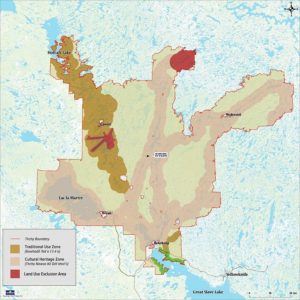Through the Canada Nature Fund, the Government of Canada recently announced that it is contributing $2 million to help conserve more than 22,000 km2 of land between Great Slave Lake and Great Bear Lake. Once complete, these two protected spaces—Gowhadõ Yek’e t’ii k’e and Tłı̨chǫ Nawoo Ké Dét’ahot’ìı—will be approximately twice the size of Cape Breton.
These protected lands include the Įdaà Trail, an ancestral trail that follows waterways and watershed areas and includes many of the best sites for traditional activities including hunting, trapping, fishing, and collecting plants used for medicine, and it occupies a central place in Tłı̨chǫ history and culture.
“Our government is proud to be working collaboratively with the Tłı̨chǫ Government to recognize and protect the significant traditional land situated between Great Slave Lake and Great Bear Lake,” said Michael McLeod, Member of Parliament for Northwest Territories. “This community-led conservation initiative represents reconciliation in action. The $2 million investment will help to protect the culture and traditional identity of the Tłı̨chǫ communities and will play a big role in helping to reach Canada’s nature protection goals.”
The investment will assist to:
- support the establishment of conserved areas
- continue to promote and protect Tłı̨chǫ culture and way of life
- contribute to biodiversity conservation targets through Indigenous-led conservation efforts
- support research into climate change
“Our land, our culture, and our way of life are what our people have always relied on and will continue to do so. The Tłı̨chǫ Wenek’e was developed through the eyes of our elders to protect and promote our way of life and the transfer of knowledge to future generations. These types of partnerships will only continue to strengthen our relationship and build on reconciliation,” said George Mackenzie, Grand Chief of the Tłı̨chǫ Government.

Map of Tłı̨chǫ Lands, indicating the Traditional Use Zone
and the Cultural Heritage Zone.
Maintaining this culturally significant land using Indigenous traditional knowledge will also help preserve and protect habitat for wildlife, including 16 species at risk like the boreal caribou, and will preserve known migration corridors for barren-ground caribou.
The federal government is bringing forward a plan to conserve 25 per cent of Canada’s lands and 25 per cent of its oceans by 2025.
For further information on Canada’s Nature Legacy initiative, click here.
Featured image from Ministry of Environment and Climate Change: Canoe Trail from Gameti to Mesa Lake on Tłı̨chǫ Land in Northwest Territories. Photo credit: Petter Jacobsen.








